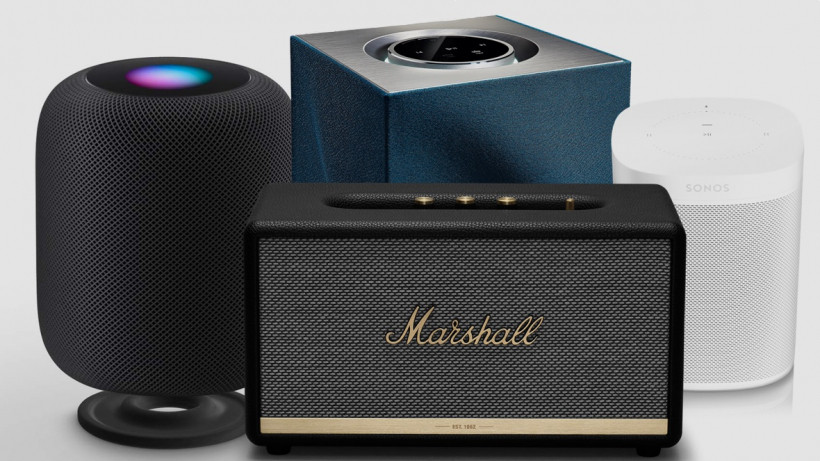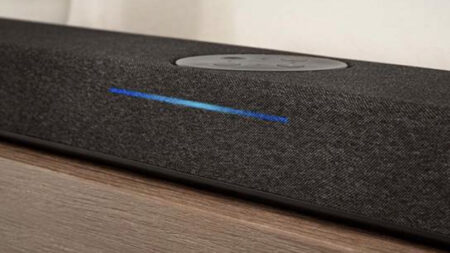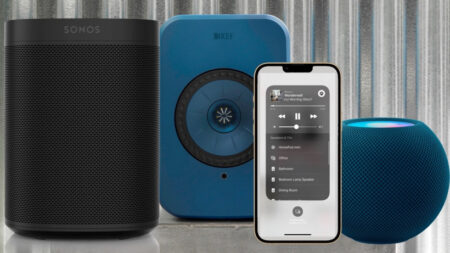Your guide of the top wireless speakers to make an awesome multi-room system
It’s hard to believe now, but there was a time when your only realistic choice was Sonos if you wanted a top wireless multi-room audio system. Happily, these days almost any wireless speaker with Wi-Fi can form part of a multi-room audio system.
Unless it’s particularly elderly, or was an especially affordable online purchase, your wireless speaker is almost certain to have compatibility with Amazon Alexa, Google Assistant, Apple AirPlay 2, DTS Play-Fi or one of the other app- or voice-based control systems. Once you have more than one, then, it’s pretty straightforward to set up a multi-room sound system. ‘Mix-and-match’ doesn’t always work, though. The desire to have a common aesthetic throughout your home, at least where your multi-room speakers are concerned, is obvious. And if you want unity of appearance, why wouldn’t you want unity of sound too?
But your choice of wireless audio and/or smart speakers is now so wide, it might be tricky to work out exactly which ones are best for you. It’s straightforward enough to narrow your choices down, though: consider if the speaker supports your favourite streaming service, for example, and think about things like additional physical connectivity you might need, or whether Bluetooth speakers could be an option.
If you’re paying for a top-tier streaming service with hi-res audio content, you’ll want to make sure your systems supports those full-fat files, as well.
And while you’re at it, make sure your favourite voice assistant is supported (if you like to control your system using your voice, of course). And, most important of all, read this buying guide to the best-sounding, best-value multi-room speaker ranges around, before making any big decisions.
Best multi-room wireless speakers at a glance
Before we jump into the big details, here’s a quick overview of the best wireless audio brands you should be considering:
- Sonos
- Bowers and Wilkins
- Apple
- Bluesound
- Ruark
- Audio Pro
- Marshall
- Naim
You can, of course, also create a multi-room wireless speaker setup using Amazon’s Echo smart speaker range, as well as setting up a multi-room system with Google Home and the Assistant.
Anyway, on with the main event… here’s our top picks of the best wireless speaker systems available now.
Sonos
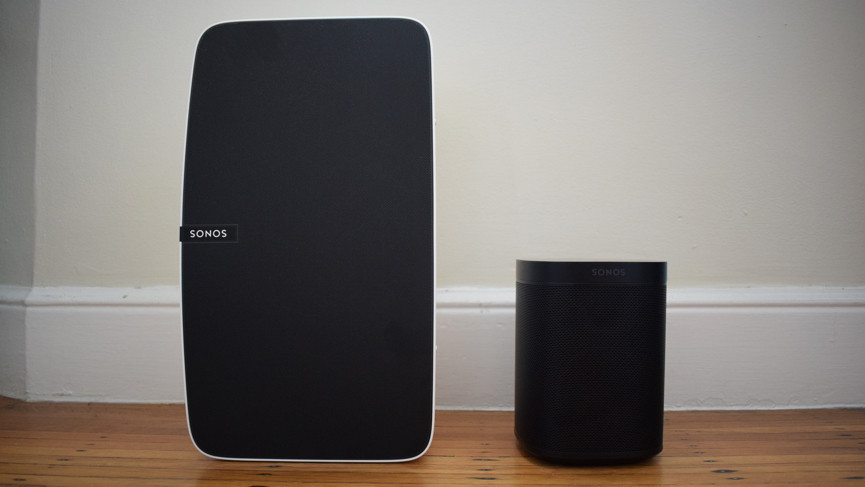
Buy Now: Amazon | From £179
There’s ubiquity, and then there’s Sonos. The company got in on the ground floor of multi-room audio, and has expanded its range over time to ensure there’s a Sonos speaker for every eventuality – and that includes home cinema sound as well.
A shrewd collaboration with IKEA has brought Sonos ownership to an even more competitive price, and its overall range of products has something for everyone.
From the Alexa-or-Google-Assistant equipped Sonos One and the battery-powered, portable Sonos Move, via the mic-free Play:5 and SL, to the TV-and-cinema-centric Playbar, Playbase and Beam, every reasonable requirement is catered for. There’s even the Sonos Amp and Sonos Port for integration into more traditional and serious hi-fi systems.
Set-up is really easy – another reason Sonos is so popular. The app, which is stable and logical, helps you through a few short steps to getting your first Sonos speaker up and running, and after that it’s simplicity itself to get music throughout your house (or, at least, into as many rooms as you have Sonos speakers). You can even set up a couple of Sonos speakers as a true stereo pair.
Unlike some rivals, there’s no facility to handle audio files above CD-standard 16bit/44.1kHz, and the Sonos system isn’t as welcoming of third-party speakers as some others – although the recent(ish) addition of Apple AIrPlay 2 makes Sonos a little more agnostic than in was before.
Only the Sonos Move has Bluetooth, and you won’t find a USB socket anywhere in the range. What you will find, though, is a killer combination of ease of use, rock-solid multi-room functionality and very decent sound. Sonos uses a mesh network on which all the speakers in your home communicate – there will be, in effect, a master speaker nearest to your router, which talks to the nearest speaker, which in turn talks to its nearest speaker… and so on.
So as long as your Sonos speaker is within reach of another Sonos speaker, getting (and staying) online is simple, and doesn’t require all the speakers to be in proximity of your router.Support for all high-profile streaming services is in place, and the Sonos app can also incorporate internet radio, podcast providers, audiobooks, you name it.
There is no rival system with a more comprehensive selection of content providers. You can even access any audio stored on your home network, too.And Sonos has gone to extraordinary lengths to deliver its Trueplay feature.
This basically measures your speaker’s position in its environment and tweaks the audio output accordingly. The portable Sonos Move can alter its playback characteristics every time you put it in a new spot.
In terms of audio quality, the Sonos range has been finessed and improved over time, and each new speaker tends to sound a little fuller a more complete than the previous model. It’s certainly not the last word in sonic quality, but it nevertheless has plenty to recommend it – all but the least expensive Sonos speakers have decent weight, impressive clarity and more than enough detail retrieval to make your music sound lively and entertaining. Which, after all, is really what it’s all about.
Apple
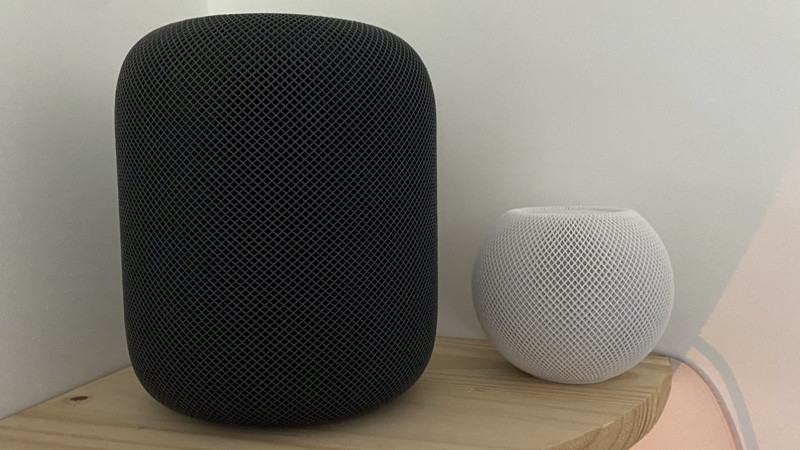
Buy Now: apple.com | From £99
Are you a big Apple fan already? Fully iOS-ed up? If so, you can get into one of the easiest-to-use, greatest-to-listen-to multi-room systems around without spending a fortune, especially since the sub-£100 HomePod Mini went live. But if you don’t have at least one foot in the Apple ecosystem already, these aren’t the speakers for you.
Setting up two as a stereo pair (for proper, authentic left-and-right stereo) is simple – but setting up a multi-room system is even easier. Your Mac or iOS device will show any and all of your HomePods on its ‘AirPlay Speaker’ list, and you can name them from there.
As long as you keep your instructions reasonably simple, Siri will happily respond to calls of “Hey Siri – play Miles Davis on the lounge” or “Hey Siri – play some Four Tet in the kitchen and the office”. DIfferent music, at different volumes, in different rooms, at the same time, is available too: “Hey Siri – play Brian Eno in the bedroom at 40% and Kanye West in the kitchen at 60%” shouldn’t be a problem. More traditional methods of controlling all aspects of playback are in the Apple Music app, too.
But as we say, you need to be all-in with Apple. The company’s not beyond behaving like other electronics brands don’t exist, and it would certainly like you to forget about any streaming service but Apple Music – although Apple is opening up the closed shop a bit and Spotify could even arrive as an option too, soon .
Obviously Spotify, Tidal, TuneIn internet radio and all the rest of the world’s music is available on HomePod – but only by getting your smartphone out to get underway. There’s no chance “Hey Siri – wake me at 8.30am with FIP radio” or “Hey Siri – play Ed Sheeran from Spotify” will get you anywhere.
Using Apple Music gives access to niceties like advanced playback controls, song and/or artist info, further listening recommendations, alternate versions and so, and in real time. Using anything else, you’re lucky if you can get beyond “Hey Siri – turn the volume up”.
At the price, the bigger HomePod’s sound quality is really quite impressive. It’s undeniably a 360-degree speaker, able to distribute music evenly and uniformly in every direction. Apple pushed the boat out with HomePod specification, to the tune of seven beam-forming tweeters in circular configuration and an upward-firing 102mm long-throw mid/bass driver.
And the results are a punchy, controlled bottom end, detailed and open midrange (which makes every vocalist sound their best) and nicely judged attack at the top of the frequency range. Apple’s few speakers products have been notoriously hit-and-miss, but HomePod is the company’s best effort by a distance.
The Mini definitely punches above its weight too. I did most of my comparison testing against the Sonos and, while it can’t match the One when you go above around 70% volume, it’s more than a match at mid-levels.
That’s not to say things get wobbly at higher levels; I’ve never heard the HomePod Mini waver or distort in my two weeks of testing – but there’s only so loud a speaker of this size can be.
Audio Pro
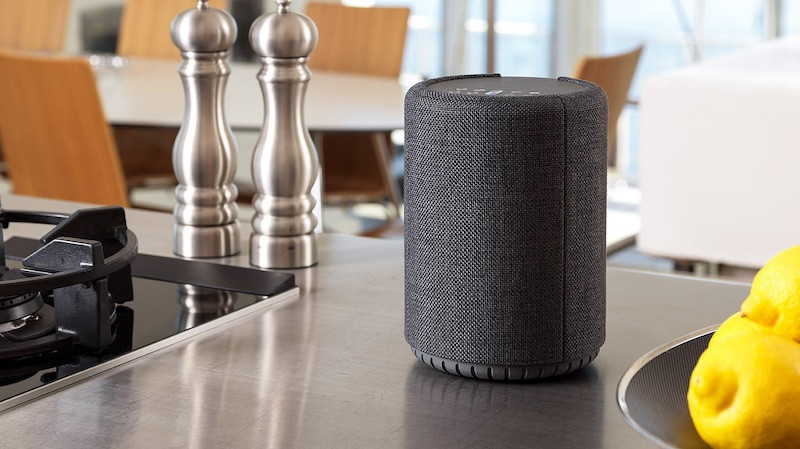
Buy Now: Amazon | From £119
Generally speaking, you can rely on the Scandinavians to deliver a bit of thoughtful design. Admittedly, in the case of Swedish specialists Audio Pro that means an extensive range of wireless multi-room speakers that mostly look a bit like startled koala bears – but behind the playful aesthetic, Audio Pro is all business.
In fact, the biggest impediment to setting up an Audio Pro wireless multi-room audio system might well be the size of the range, and the number of finishes available.
But once you’ve established the sort of size of koala-faced speaker each room requires, and once you’ve picked a finish, and once you’ve dismissed both the anonymously cylindrical A10 speaker and the huge, completely bonkers Drumfire speaker, it won’t take long to get your system up and running.
Physical inputs run to stereo RCA and 3.5mm analogue sockets, and Ethernet for absolute network stability too. Wirelessly, you’re looking at Bluetooth, Apple AIrPlay, Spotify Connect and (of course) Wi-Fi.
There’s a bespoke app to help with multi-room set-up – but, while it’s a logical enough ‘drag’n’drop’ proposition, it’s rather buggier than most of the alternative apps in this list. It’s not enough to make the Audio Pro experience a non-starter, but it doesn’t do anything to make it any more enjoyable.
Happily, even with the app’s stutters and lags it doesn’t take too long to set up your whole-house system. And from there, you can leave your app-based woes behind and concentrate instead on the remarkable balance and fidelity of the Audio Pro presentation.These are not expensive speakers by prevailing standards – even the massive Drumfire, at £649, is more affordable than Naim’s cheapest alternative.
Yet they have an assertive, confident quality to their sound that somehow makes them sound quite a lot pricier than they actually are.
Ultimately, it’s all about balance – and the Audio Pro range is very well judged in this respect. No part of the frequency range sticks out, no part is understated – instead, the Audio Pros deliver a full-range performance, alive with detail and subtlety, and with the drive and dynamism to bring your music to life. Just grit your teeth during the initial set-up of your multi-room system, because after that there is very little downside to Audio Pro ownership.
Bluesound
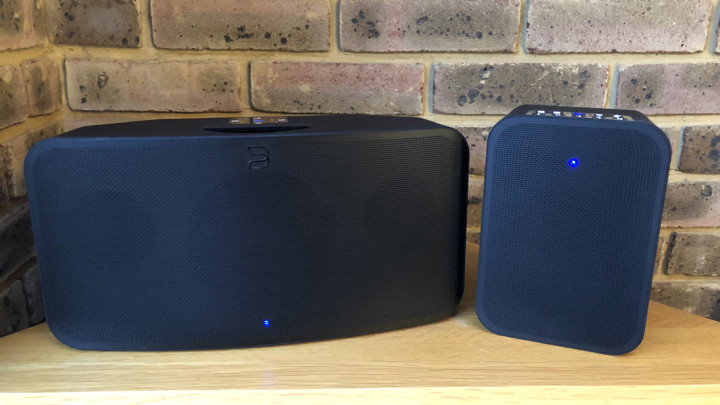
Buy Now: Amazon | From £299
Everyone has their own particular priorities when it comes to choosing audio or home entertainment kit. Value for money, ease of use, looks… these are all important. They’re not as important as sound quality, though – or, at least, we don’t think so.
Which is where Bluesound comes in. Developed as a stand-alone company by the hi-fi stalwarts at long-established British audio company NAD, in considerably less than a decade Bluesound has become one of the most compelling multi-room audio companies around.
An extensive range, that covers both home cinema and multi-room music, and a no-compromise commitment to high-resolution audio quality, has made Bluesound an authentic contender.
Certainly the range has something for everyone. Starting with the Pulse Flex 2i wireless speaker, the bigger Pulse Mini 2i and bigger-still Pulse 2i, there’s a speaker for every occasion. Then there’s the Pulse Soundbar 2i for wireless hi-res home cinema sound, plus a range of music streamers, streamer/amps and streamer/amp/NAS devices. From ‘simple’ to ‘elaborate’, Bluesound has your multi-room requirements covered.
Bluesound was the first multi-room system to support MQA-powered TIDAL Masters hi-res audio files, and it also covers Spotify, Napster, Deezer and Qobuz. All Bluesound speakers can operate at up to 24bit/192kHz, with aptX Bluetooth on board in case you fancy an unsupported music service (Primephonic, for instance).
Digital optical and 3.5mm analogue inputs offer yet more flexibility, and there are USB sockets for thumb drives too. Apple AirPlay 2 means Siri control is available, and there’s Amazon Alexa integration too. Or you can always use the Bluesound control app – it looks a fair bit more complicated than it actually is, so don’t be put off.
Set-up involves each speaker creating its own little Wi-Fi network, which connects via your smartphone’s settings – all you need to do is enter your Wi-Fi details into the app. It’s as straightforward as these things ever are, as it won’t take long before you’re enjoying lovely hi-res multi-room sound.
And thanks, no doubt, in part to the strong audio heritage at Bluesound’s foundations, the sound quality available here is not to be sniffed at. It’s detailed, expressive and refined, with brilliantly natural and convincing musicality across the board.
This is far from the sort of reproduction you might be expecting when you consider the price and wireless convenience of these speakers – the combination of punch and precision makes every song an event. No matter if you like to listen to hi-res classical music or potent pop music via a bog-standard Spotify stream, the Bluesound range is ready to put a rocket up it.
Bowers & Wilkins
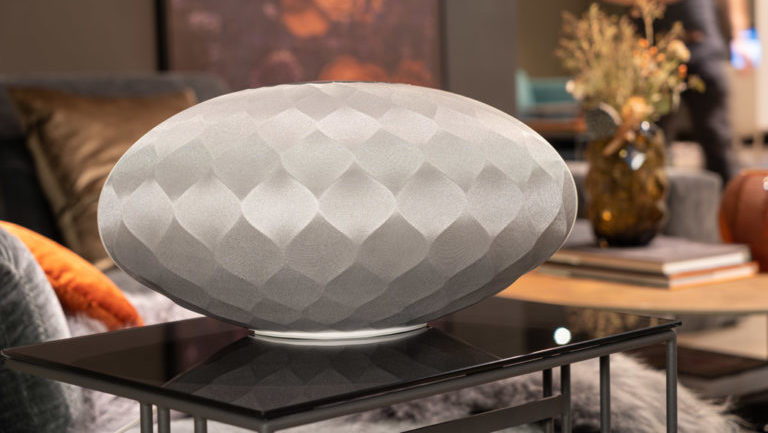
Buy Now: bowerswilkins.com | From £299
It turns out that Bowers & Wilkins was just keeping its powder dry. For a company that was one of the first to develop the idea of a ‘premium’ wireless speaker, a B&W wireless multi-room system was conspicuous only by its absence.
Rivals gobbled up market share. And then Bowers & Wilkins launched the Formation range, and the audio world returned to its axis.
Formation is an extensive and well-considered range of hi-res capable wireless products. It starts with the reasonably conventional-looking Formation Flex; a couple of which can easily be turned into a stereo pair. Then there’s the not-at-all conventional-looking Formation Wedge – the spiritual successor to the late, lamented B&W Zeppelin speaker, this £899 stand-alone oddball is capable of delivering stereo sound all by itself.
And the audio range is topped off by Formation Duo: £3,999-worth of extremely serious wireless stereo speakers.
Home cinema fans can get in on the action too – there’s the Formation Bar (yes, these model names are really quite literal) and Formation Bass (go on, guess). And finishing off an extremely comprehensive range is Formation Audio, a wireless streamer that can turn a regular system into a wireless wonder and also allows analogue sources (a turntable, say) to stream wirelessly to a Formation speaker.
Set-up is via a brief, clean app – the Formation speakers establish their own mesh network on which to operate, rather than sitting on your home Wi-Fi network. This allows much greater stability, and also means Bowers & Wilkins can claim a lightning-fast one-microsecond synchronisation between speakers. So if you want music to follow you around your home utterly seamlessly, this is the system for you.
Mind you, it might well also be the system for you if you value sound quality highly. Music can be delivered to the Formation via aptX HD Bluetooth, Spotify Connect or Apple AirPlay 2 – and the whole range is Roon Ready too, so any music stored on the local network is available too. And all at the B&Ws’ native 24bit/96kHz audio quality.
In every meaningful way, the Formation range deals confidently with your music. Low-end extension, midrange precision and high-end attack are all judged well. Timing is good, stereo focus (in the stereo products, at least) is impressive, and the overall tonality is neutral and natural.
These are articulate, revealing products that have exactly the sort of sonic qualities you should expect from Bowers & Wilkins. And all in a simple-to-use multi-room system.
Marshall
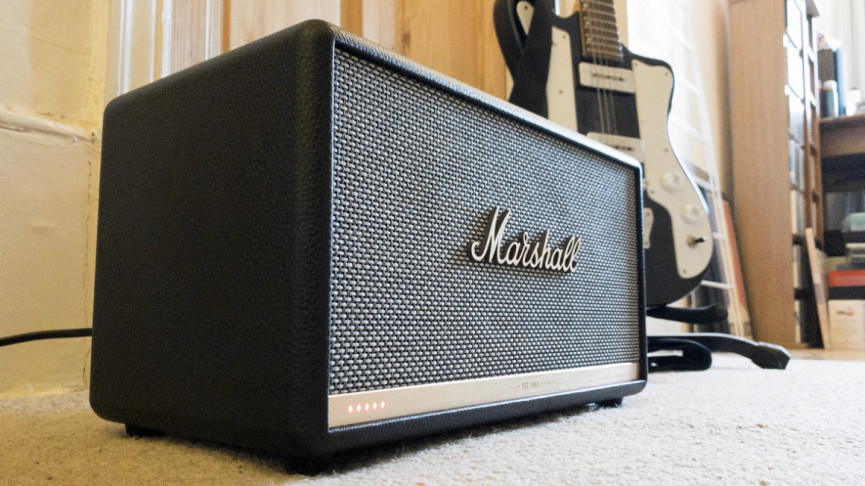
Buy Now: Amazon | From £149
Have a look at the rest of the speakers in this round-up. See how hard they try to fit in with your decor and wider lifestyle? Well, Marshall isn’t having that. Unless your home is styled to look like a mosh-pit, the Marshall range of wireless multi-room loudspeakers is going to stick out like a bull mastiff in a poodle parlour.
It’s fair enough, though. That ‘Marshall’ logo is as iconic as any brand in popular music – and why wouldn’t you want some miniature guitar amps dotted around your home?
The Marshall multi-room range is ever-growing. There’s the Acton, the bigger Stanmore and the just-plain-big Woburn. The first two are also available as Acton II Voice and Stanmore II Voice – as the names imply, they’re both compatible with Amazon Alexa voice control. As is the newest member of the bunch, the diddy Uxbridge Voice.
The Marshall control app is straightforward enough (and quite nice to look at), and it makes establishing a multi-room system simple. The app incorporates Chromecast built-in, Spotify Connect, Apple AirPlay and Bluetooth – so a whole planet’s-worth of music should be available with just a button-push or two.
And, if you’re struggling for content, there’s also a couple of analogue inputs (3.5mm and stereo RCA) for attaching legacy equipment.
Quite a big part of the Marshall range’s appeal is the aesthetic, of course, and there is more satisfaction to manually operating these speakers than any of the others here (bar the Naim range). The rotary controls on the top of the cabinets are tactile, weighty and just what you want from a speaker that’s pretending it’s part of the back-line at a Motorhead gig.
And as is probably appropriate, the Marshall multi-room range sounds just as unequivocal as it looks. Compared to the (considerably more expensive) Bowers & Wilkins or Naim alternatives, it’s a little blunt and lacking in outright finesse – but that’s to miss the point somewhat. The overall Marshall sound is big and bold, with lots of attack and dynamism – it’s not every speaker that sounds like it’s playing loud even when the volume dial is between ‘1’ and ‘2’, but this Marshall range sounds like it’s in overdrive every time you fire it up.
Naturally, this won’t suit everyone. But those who like to be thrilled and energised by their music will love the Marshall range – add in the unique looks and you’ve a range that can satisfy one every level.
Ruark
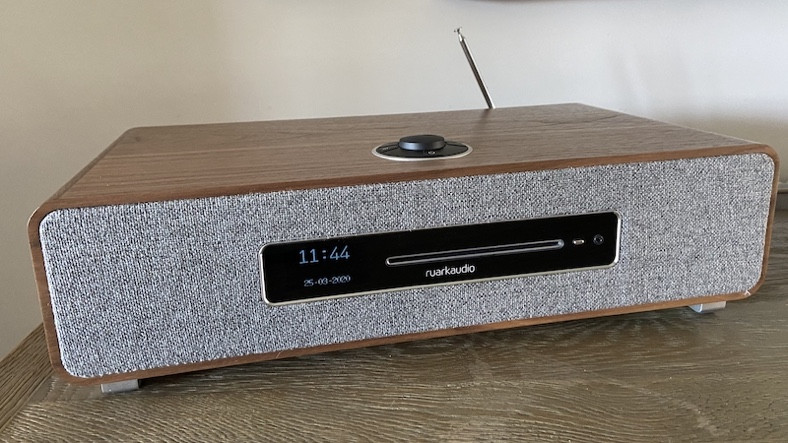
Buy Now: Amazon | ruarkaudio.com | From £399
Just look at this thing. Look at it. It’s a thing of rich walnut veener beauty and, what’s more, it sounds absolutely brilliant as well. It’s the Ruark R5, an integrated music system that sits towards the top end of the UK-based company’s multiroom lineup, costing £999.
If you’re looking for an even bigger statement from a showpiece speaker system then the R7 Radiogram (£2,300) might be just the ticket. Whatever model you choose, you’re getting music streaming, a CD player, DAB+ and FM radio, aptX HD Bluetooth and plenty of ports to hook up to other sources such as a turntable or a TV.
These high end speakers all play a part in the overall Ruark multi-room platform through the dedicated Ruark Link app, which is one of the least clunky we’ve used; although you can also control proceedings through Spotify Connect. There’s no AirPlay support though, sadly.
Android users should note though, that the Link app isn’t actually available at present on Google Play – but there is a third party app (Undock) that plays nicely.
In total you can have a maximum of six speakers from the Ruark connected family synced up for multiroom audio. As well as the heavy hitting duo listed above, there’s also the R2 (£419) and MRx (£399) bookshelf speaker options too. When streaming a CD, the bandwidth isn’t as much of an issue as you’d imagine as system streams the CD at a compressed “radio” quality to the other speakers.
With the R7, there’s also a brilliant audio visual mount (£79) that allows your TV and set-top box to seamlessly fall inline with the Ruark design aesthetic.
Away from the connected range detailed above, Ruark also has a more entry level system – the MR1 – comprising of a couple of Bluetooth speakers.
Naim
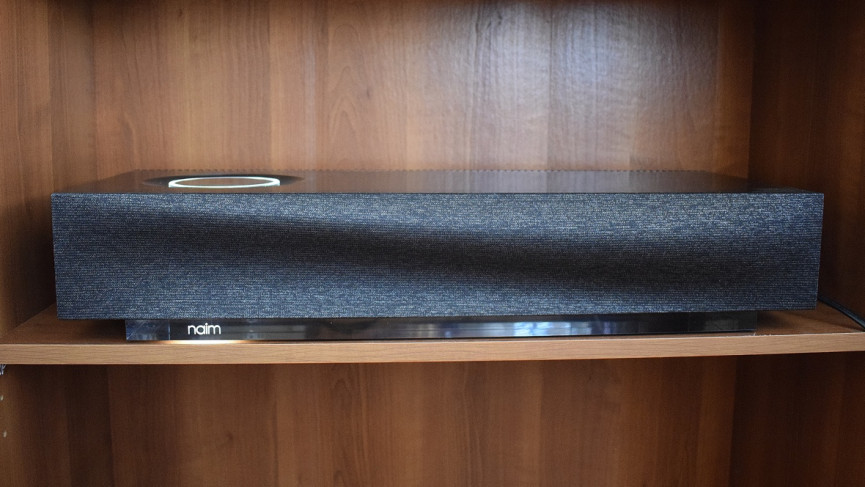
Buy Now: Amazon | From £749
Naim has double the amount of wireless speakers Apple has in its line-up – that’s right, a whole two. But what your admittedly significant outlay buys are the products of an established, even venerable, high-end hi-fi company with more than enough expertise to blow your socks off.
If it’s no-holds-barred performance you want, bite the financial bullet and reap the sonic benefits.The junior partner is the range is the £749 Mu-so Qb 2, the chairman of the board the £1,299 Mu-so. And both devices look and feel the money’s-worth.
They sit on a slab of illuminated Perspex, have luxurious-feeling grilles (available in quite a number of very tasteful finishes) and are topped off with a large, illuminated, smooth-scrolling and wildly tactile control wheel. There’s ‘works with Alexa/Google Assistant’ voice control available, which needs a mic-equipped speaker on the same network, or there’s a passably stable control app. Neither method can lay a glove on that wheel, though.
Qb2 is compact enough to sit on a shelf or a worktop. At very nearly 63cm wide, Mu-so needs a more significant surface to stand on – mind you, it has an HDMI ARC socket in order to give a boost to your TV’s sound, so maybe just below your television would be best.
Both products have digital optical and 3.5mm analogue connections, USB ports for both charging and playing iOS equipment, aptX Bluetooth and Apple AIrPlay 2 connectivity, Google Cast and Spotify Connect, UPnP, internet radio… the word ‘flexible’ can safely be applied here.
Every imaginable digital file format is supported, and the Mu-so duo is capable of full-on hi-res 24bit/192kHz playback.Getting up and running is dead easy, particularly for Apple users. AirPlay can seamlessly share your wi-fi settings between your phone or tablet and the speakers.
And it can do that with every additional speaker you bring into the system, so building a multi-room set-up takes no time at all. Music can be streamed directly from the Naim control app (for both iOS and Android), and there’s the ability to integrate some of your favourite streaming services in there too. By the standards of super-convenient wireless multi-room speakers – even expensive ones – both these Naim products sound superb.
Even if you’re a stranger to the Naim brand, just a swift listen will confirm you’re dealing with a hi-fi company that knows precisely what it’s doing. Performance is fluent and articulate, engaging and entertaining – it’s completely convincing, from the low, textured bass notes to the bright, shining treble. Fire up some of your favourite tunes in any room, and you’ll be in no doubt as to where your money’s gone.


